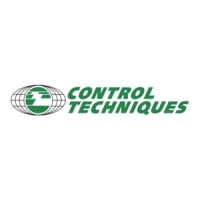Mentor ll User Guide 55
Issue Number: 12 www.controltechniques.com
Menu 06: Field Control
The Mentor II is equipped with field control as part of the on-board
software. If a motor is being used with an uncontrolled (fixed) field
supply, this menu does not apply.
Provision is made for programming two selectable values of maximum
field current. Further, the lower value of maximum field current can be
controlled by a programmable timer so that, when the Drive is not
running, the field can be switched automatically to economy mode.
The resulting field current demand is summed algebraically with the field
current feedback to produce a current error which is the input to the field
current loop. The output of the field current loop is the firing angle,
subject to the front endstop limit.
The field current can alternatively be controlled directly by either of the
maximum field parameters 06.08 and 06.09 via a programmable input or
by application software, and there is a facility for direct control of the
firing angle, useful for diagnosis.
Field current demand is the output of the back-emf voltage loop, subject
to programmed maximum and minimum field current values. The voltage
loop compares the calculated back-emf value with a programmed set
point which is used as factor in determining field current demand.
The voltage loop output, and consequently the field current demand, is
maximum when the calculated back-emf is less than the setpoint value.
When the calculated value exceeds the set point value (at base speed)
the voltage loop reduces the field current demand to regulate the
calculated back-emf to the set point value.
Alternatively, the user may wish not to use the voltage loop, but to enter
a current demand directly. The user can set two maximum field current
parameter values. In this mode, the value of the back-emf set point
should be set to maximum, such that the voltage loop always demands
maximum field current. The current demand is then the selected
maximum field current parameter.
The calculated motor back emf based on armature voltage minus IR
compensation value 2, 06.05. Feedback to the emf loop in spillover
mode.
The current demand from the emf loop, subject to the limits of 06.08,
06.09 and 06.10.
Feedback to the field current loop
Scaling 06.04 = 1000 corresponds to fully phased forward
The value resulting from the application of 06.06 to the speed error
integral input.
A programmable factor used for calculation of the armature IR-drop as
correction to measured armature voltage, to allow the back emf to be
computed.
If 06.20 =0:
If 06.20 =1:
Example of setting of 06.06
Armature voltage = 400V
Armature current = 200A
Armature resistance = 0.1Ω
I x R =20V
For a M210 with 200A armature current
03.08 = 635 units
so,
06.07 = 380V
The programmable value of the armature back emf in volts, at which the
field begins to weaken. Defined as the voltage at which base speed is
reached.
Programmable value of the maximum current demand of the emf loop. If
the field control is to be used in current mode, this parameter would
become the current reference of the field control loop, and the back emf
set point should normally be set to maximum to prevent spillover
occurring; alternatively, if motor overvoltage protection by spillover is
required, the back emf set point should be set to maximum armature
voltage.
Alternative to 06.08, for use as an economy setting. Refer to 06.12,
06.14 and 06.15.
06.01 Back emf
RO Uni
ô
0 ~ 1000
ð
06.02 Field current demand
RO Uni
ô
0 ~ 1000
ð
06.03 Field current feedback
RO Uni
ô
0 ~ 1000
ð
06.04 Firing angle
RO Uni
ô
261 ~ 1000
ð
06.05 IR compensation 2 output
RO Bi
ô
±1000
ð
06.06 IR compensation 2
RW Uni
ô
0~255
ð
000
06.07 Back emf set point
RW Uni
ô
0 ~ 1000
ð
+1000 V
06.08 Maximum field current 1
RW Uni
ô
0 ~ 1000
ð
+1000
06.09 Maximum field current 2
RW Uni
ô
0 ~ 1000
ð
+500
06.05
03.08()06.06()×
2048
----------------------------------------------
=
06.05
04.02()06.06()×
2048
----------------------------------------------
=
06.06
20 2048×
635
--------------------------
64units==

